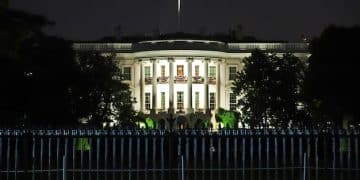Voting Rights Act 1965: Shaping the 2024 US Electorate

The 1965 Voting Rights Act (VRA) fundamentally reshaped the American electorate by outlawing discriminatory voting practices, particularly impacting the Southern states and leading to increased political participation among racial minorities, a legacy that continues to influence elections in 2024 and beyond.
How did the 1965 Voting Rights Act Shape the 2024 Electorate? A Historical Analysis reveals the profound and lasting impact of landmark legislation on the composition and dynamics of American voters well into the 21st century.
The Context of the 1965 Voting Rights Act
The Voting Rights Act of 1965 stands as a crucial piece of legislation in American history. Understanding the context in which it was created is essential to appreciating its transformative power over the electorate.
What were the conditions that necessitated such a sweeping law?
Discriminatory Practices Before the VRA
Prior to 1965, many states, particularly in the South, employed various tactics to disenfranchise African American voters.
- Literacy Tests: These tests required voters to demonstrate their reading and writing abilities, often administered unfairly to prevent Black citizens from registering.
- Poll Taxes: Requiring voters to pay a fee before casting their ballot, poll taxes disproportionately affected poor African Americans.
- Grandfather Clauses: These clauses allowed individuals to vote only if their ancestors had voted before the Civil War, effectively excluding most Black citizens.
- Intimidation and Violence: The threat and use of violence against Black citizens attempting to register or vote created a climate of fear and further suppressed their participation.
These strategies effectively suppressed African American voter turnout, maintaining a system of racial inequality at the polls. The VRA was designed to dismantle these barriers and ensure equal access to the ballot box for all citizens.
Key Provisions of the Voting Rights Act
The Voting Rights Act of 1965 was a comprehensive piece of legislation with several key provisions that fundamentally altered the electoral landscape.
These provisions were designed to dismantle discriminatory practices and ensure equal access to the ballot box, but what exactly did the VRA do?
Section 4 and the Coverage Formula
Section 4 of the VRA established a coverage formula that identified jurisdictions with a history of voting discrimination. These jurisdictions were required to obtain preclearance from the federal government before making any changes to their voting laws or procedures.
Banning Literacy Tests and Other Discriminatory Devices
The VRA explicitly outlawed literacy tests and similar devices used to disenfranchise voters. This provision eliminated a major barrier to African American political participation in the South.
Federal Oversight of Elections
The Act authorized the federal government to send federal examiners and observers to monitor elections in covered jurisdictions. This provision ensured that elections were conducted fairly and without discrimination.
These key provisions of the VRA were instrumental in increasing African American voter registration and turnout in the years following its passage.
Impact on Voter Registration and Turnout
One of the most immediate and significant effects of the Voting Rights Act was a dramatic increase in voter registration and turnout among African Americans, particularly in the Southern states.
How did the VRA achieve such a substantial increase in voter participation?
Dramatic Increase in Black Voter Registration
In the years following the passage of the VRA, African American voter registration rates soared in states that had previously employed discriminatory practices. For example, in Mississippi, Black voter registration jumped from less than 7% in 1964 to nearly 60% by 1967.
Increased Turnout in Elections
With increased registration came increased turnout. African Americans began to participate in elections at higher rates, wielding greater political influence in their communities and states.
Empowerment of Minority Communities
The VRA empowered minority communities by giving them a voice in the political process. This led to increased representation in government and a greater focus on issues important to these communities.

Shifting Political Landscape in the South
The Voting Rights Act not only increased voter participation but also reshaped the political landscape of the South, leading to significant changes in representation and policy.
How did the VRA transform the political dynamics of the region?
Rise of Black Elected Officials
As African Americans gained greater political influence, more Black candidates began to win elections at the local, state, and federal levels. This led to a more diverse and representative government.
Increased Responsiveness to Minority Concerns
With a larger and more engaged Black electorate, politicians became more responsive to the needs and concerns of minority communities. Policies were enacted to address issues such as education, housing, and employment discrimination.
End of the Solid South
The VRA contributed to the decline of the “Solid South,” the historical dominance of the Democratic Party in the region. As African Americans gained voting power, the Republican Party began to make inroads in the South, appealing to white voters who were resistant to the changing political landscape.
Challenges to the Voting Rights Act
Despite its initial success, the Voting Rights Act has faced numerous challenges over the years, including legal challenges and attempts to weaken its provisions.
What are some of the most significant threats to the VRA’s continued effectiveness?
Shelby County v. Holder (2013)
In 2013, the Supreme Court struck down Section 4 of the VRA in the case of *Shelby County v. Holder*. The Court argued that the coverage formula was outdated and no longer reflected current conditions.
Impact of the Shelby County Decision
The *Shelby County* decision had a profound impact on voting rights in the United States. Without the preclearance requirement, many states with a history of discrimination began enacting new voting restrictions, such as voter ID laws and cuts to early voting.
Ongoing Legal Battles
Despite the *Shelby County* decision, legal battles over voting rights continue to be fought in courts across the country. Civil rights groups and voting rights advocates are working to challenge discriminatory voting laws and protect the right to vote for all citizens.
The VRA and the 2024 Electorate
The legacy of the Voting Rights Act continues to shape the American electorate in 2024 and beyond. Despite the challenges and setbacks, the VRA has had a lasting impact on voter participation, representation, and policy.
How does the VRA’s influence manifest itself in today’s electorate?
Increased Diversity of the Electorate
The VRA has contributed to a more diverse electorate, with higher rates of participation among racial and ethnic minorities. This increased diversity has the potential to shape election outcomes and policy priorities.
Ongoing Debates over Voting Rights
Debates over voting rights continue to be a major part of the political discourse in the United States. Issues such as voter ID laws, early voting, and gerrymandering remain contentious, with both sides arguing about their impact on voter participation and fairness.
The Future of Voting Rights
The future of voting rights in the United States is uncertain. With ongoing legal challenges and political divisions, it is unclear whether the VRA will be strengthened or further weakened in the years to come.
The Voting Rights Act was a transformative piece of legislation that empowered marginalized communities and reshaped the American political landscape. While challenges remain, its legacy continues to influence elections and policy in the 21st century.
| Key Point | Brief Description |
|---|---|
| 🗳️ Ending Discrimination | The VRA eliminated discriminatory voting practices like literacy tests. |
| 📈 Increased Turnout | Significantly boosted minority voter registration and turnout. |
| ⚖️ Legal Challenges | The VRA has faced numerous legal battles, impacting its effectiveness. |
| 🌍 Shifting Politics | Transformed the political landscape, especially in the Southern US. |
Frequently Asked Questions
▼
The main purpose was to overcome legal barriers at the state and local levels that prevented African Americans from exercising their right to vote as guaranteed under the 15th Amendment to the U.S. Constitution.
▼
It banned literacy tests and other discriminatory devices, and it authorized federal oversight of voter registration in states with a history of discrimination. This helped eliminate barriers to voter registration.
▼
This 2013 Supreme Court decision struck down Section 4 of the Voting Rights Act, which determined which states needed federal preclearance before changing their voting laws. This led to concerns about new voting restrictions.
▼
The VRA led to increased representation of African Americans in elected offices at all levels of government, from local positions to Congress, reflecting a shift in political power and representation.
▼
It continues to influence voter turnout among minority groups and shapes ongoing debates about voting access and fairness. The VRA’s legacy is a key part of discussions on election integrity and voter suppression efforts.
Conclusion
In conclusion, the 1965 Voting Rights Act stands as a watershed moment in American history, fundamentally reshaping the electorate by dismantling discriminatory practices and empowering marginalized communities. While the VRA has faced challenges and setbacks, its legacy endures, continuing to shape debates about voting rights and access in the United States.





